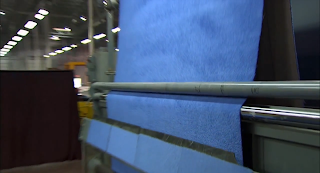We usually think of carpet as something that lasts years or even decades. However, carpet’s ability to provide comfort, reduce noise, and offer an attractive design makes it a key component of the estimated 100,000 tradeshows and conferences worldwide every year. The floors and aisles around the exhibition booths are covered in carpet that has been selected, cut, and freshly installed specifically for an event that may only run for a few days.
 |
| CES 2011 Show Floor (ETC@USC/Flickr.com/CC) |
Consider the annual Consumer Electronics Show in Las Vegas, which featured 3,239 exhibitors over 1.8 million square feet for four days in 2012. As you can see in the picture above, nearly every inch of the show floor is covered in carpet. The large size of these exhibitions and their short lifespan is one of the many reasons why the tradeshow industry is one of the largest users of carpet. Freeman is the largest service provider in this industry and provides logistics for over 11,000 events per year, including 135 of the 250 largest tradeshows in the US.
Freeman has an inventory of 3.2 million square yards of carpet that they rent to clients for events. While Freeman strives to offer their customers a wide variety of carpet including classic, custom and prestige colorfast carpet with borders, patterns and logo applications, they also hold themselves accountable to provide a greener service as well. For example, Freeman uses 98 percent recycled foam carpet padding, and also offers plastic carpet covering (Visqueen) containing between 50 and 75 percent recycled content.
Beyond the carpets’ actual characteristics, perhaps Freeman’s most laudable practice is their carpet recycling. Following every tradeshow, rather than tearing up and disposing the well-trodden carpet, Freeman transports it back to their warehouses. They match like pieces of carpet together and seam them together into a roll that can be washed and reused. Aisle carpets are typically used 4 to 5 times and booth carpet used 6 times before reseaming isn’t possible or it doesn’t otherwise meet Freeman’s standards.
 |
| Recovered and cleaned carpet, ready for another show |
A video of the carpet recovery and cleaning process can be seen here.
Freeman uses polypropylene-based carpets because they have the best color accuracy and are easiest to match during reseaming. Unfortunately, this limits the opportunities for carpet recycling once the carpet is considered unusable. In spite of this, Freeman has recycled over 60 million square feet of used aisle carpet since 2006. Some of the carpet is recycled into drainage pipe for septic systems and is reused in the manufacture of pet-related products, while higher-end carpet is sold for reuse in affordable rental housing applications.
Freeman applies a lifecycle analysis for all the products they use at their tradeshows and is look at improving sustainability beyond carpet. For example, their rental booths are not only reusable, but consist of panels and aluminum that can be easily recycled. Freeman is also now trialing a program to reduce the use of Foamcore and other Styrofoam-backed sign materials.
Freeman’s sustainability efforts were also recently honored by the 2013 Trade Show Executive Readers’ Choice Innovation Awards, which selected Freeman as the winner in the “Most Innovative Green Initiative by a Service Provider” category. The award recognized Freeman for its company-wide sustainability efforts including a recent effort to recycle plastics from various waste streams – including cigarette butts – into new plastic exhibit shelves.
Given the size of the billion-dollar trade show industry, Freeman recognizes the value of small decisions throughout their business. “Small incremental change multiplied over our size and scope can make a huge impact”, says Carrie Freeman Parsons, Vice Chair of Freeman.




